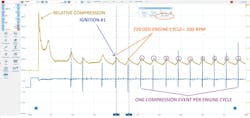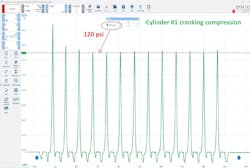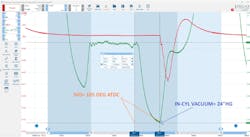Welcome back to another edition of “The data doesn’t lie,” a regular feature in which I pose a puzzling case study, followed by the answers to the previous issue’s puzzle.
Today's subject vehicle comes from my friend Gilbert. He was called upon to address a 2016 Jeep Cherokee with 2.4L engine. The shop analyzing the vehicle was tasked with determining what was mechanically wrong with the engine.
The engine suffered from a “crank/no-start” complaint and the cranking cadence offered what sounded like erratic compression for perhaps several cylinders. In fact, it sounded as if only one cylinder was able to produce compression at all. The relative compression trace here proves it (Figure 1). He took the opportunity to capture cranking-compression waveforms for all four cylinders. Indeed three of the four cylinders were extremely low of cranking-compression. However, the No. 1 cylinder produced about 120 psi of compression (Figure 2).
Developing the Diagnostic Game Plan
Knowing there were low-compression readings for almost all cylinders was simply the result of an underlying problem, Gilbert captured cranking-compression for cylinder No. 1 versus intake pressure pulse to see if any further clues were offered leading to what the root cause was (Figure 3). The RED trace is derived from the pulse sensor connected to the intake manifold. The GREEN trace is from the in-cylinder pressure transducer in cylinder No. 1 during cranking-conditions.
Adding Up the Clues
During an engine cycle, only a single change in intake pressure occurred. This is signified by the visible drop-in-pressure on the RED intake pulse trace. The timing of this negative pulse correlates directly with the opening of the cylinder No. 1 intake valve. However, the in-cylinder vacuum developed during the induction stroke is -12.49 psi (nearly 24”hg). This is caused by a significantly delayed intake valve opening (“IVO”) event and is displayed by the delta-time between the two vertical cursors.
The Data Doesn’t Lie
With all the information in front of us, and the desired information not yet obtained, we are faced with deciding how to proceed. Here are some bullet points of what we know to be factual, and I will ask all of you, diligent readers, for your input on what they mean to you, collectively:
- One of the four cylinders can produce compression.
- Only cylinder No. 1 is contributing to the intake manifold.
- The cylinder can seal properly and shows no sign of a leak.
- The timing of the intake valve opening is significantly late.
Given This Information, What Would You Do Next?
- Retime the camshafts.
- Measure the duration of the intake valve for cylinder No. 1.
- Replace engine due to damage low-end.
- Dose each cylinder with oil to increase compression ratio.
About the Author
Brandon Steckler
Technical Editor | Motor Age
Brandon began his career in Northampton County Community College in Bethlehem, Pennsylvania, where he was a student of GM’s Automotive Service Educational program. In 2001, he graduated top of his class and earned the GM Leadership award for his efforts. He later began working as a technician at a Saturn dealership in Reading, Pennsylvania, where he quickly attained Master Technician status. He later transitioned to working with Hondas, where he aggressively worked to attain another Master Technician status.
Always having a passion for a full understanding of system/component functionality, he rapidly earned a reputation for deciphering strange failures at an efficient pace and became known as an information specialist among the staff and peers at the dealership. In search of new challenges, he transitioned away from the dealership and to the independent world, where he specialized in diagnostics and driveability.
Today, he is an instructor with both Carquest Technical Institute and Worldpac Training Institute. Along with beta testing for Automotive Test Solutions, he develops curriculum/submits case studies for educational purposes. Through Steckler Automotive Technical Services, LLC., Brandon also provides telephone and live technical support, as well as private training, for technicians all across the world.
Brandon holds ASE certifications A1-A9 as well as C1 (Service Consultant). He is certified as an Advanced Level Specialist in L1 (Advanced Engine Performance), L2 (Advanced Diesel Engine Performance), L3 (Hybrid/EV Specialist), L4 (ADAS) and xEV-Level 2 (Technician electrical safety).
He contributes weekly to Facebook automotive chat groups, has authored several books and classes, and truly enjoys traveling across the globe to help other technicians attain a level of understanding that will serve them well throughout their careers.



